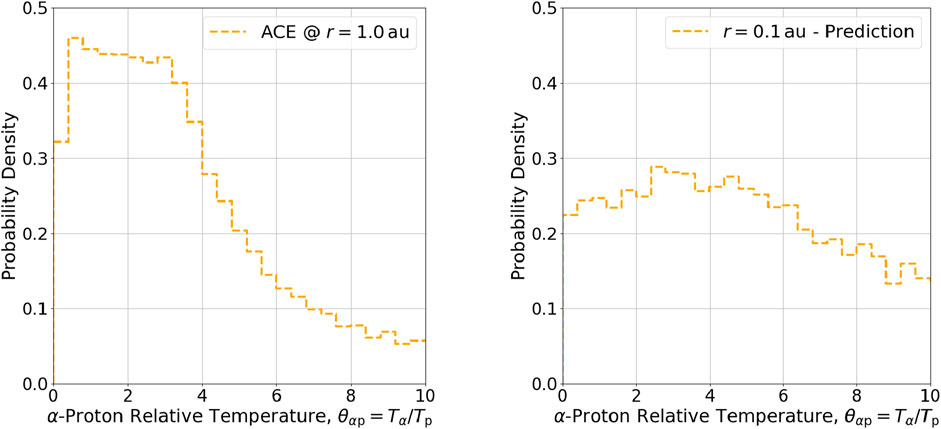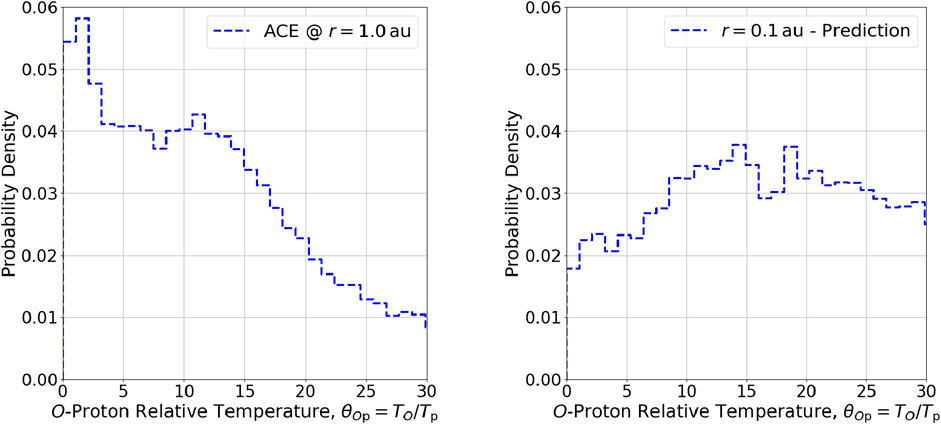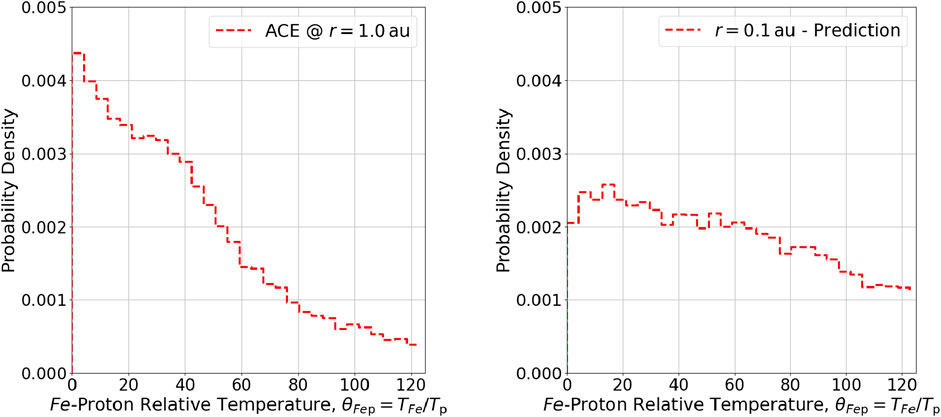- Department of Physics and Astronomy, University of Delaware, Newark, DE, United States
Introduction: As the solar wind transits through the heliosphere, Coulomb collisions among constituent particles drives it toward local thermodynamic equilibrium. Prior studies of ion collisions in the solar wind have focused on the two most abundant solar wind ions: protons (ionized hydrogen) and α-particles (fully ionized helium).
Methods: Some of the studies have used the technique of collisional analysis to incorporate the effects of collisions and expansion, to extrapolate the evolution of solar-wind ion temperature ratios. This study is the first to apply collisional analysis to the minor ions in the solar wind: carbon, oxygen and iron. Observations of ion temperature ratios in the near-Earth solar wind (r = 1.0 au) are used to predict their values closer to the Sun (r = 0.1 au).
Results: Ion measurements from the Advanced Composition Explorer (ACE) mission were used as individual boundary conditions for the equations of collisional analysis, which were solved numerically to make predictions of the temperature ratios. By using a large dataset spanning twelve years, the distributions of ion temperature ratios measured at r = 1.0 au can be compared to those predicted at r = 0.1 au.
Discussion: The predicted distributions suggest that the ratio of minor-ion temperatures to that of protons is significantly higher closer to the Sun, which is consistent with expectations for a zone of preferential minor-ion heating in/near the solar corona.
1 Introduction
While the solar wind is primarily composed of protons,
A commonly studied non-LTE features of the solar wind is unequal ion temperatures, which can be quantified by the ratio
where
Section 2 provides an overview of collisional analysis applied to ion temperature ratios. The data used in this study are described in Section 3. Section 4 describes the results of applying collisional analysis to these data, and Section 5 summarizes the study’s key findings.
2 Methodology
Collisional analysis, which was first introduced by Maruca et al. (2013), is an analytical method for quantifying the effects of collisions on the non-LTE features of an individual parcel of solar-wind plasma. The work of Maruca et al. (2013) and Johnson et al. (2023) focused on the unequal temperature of
where
is the Coulomb logarithm and
Equation 2, after substituting Equation 3 can be numerically integrated using a set of in-situ measurements as a boundary condition to find the radial evolution of the temperature ratio:
The scaling relationships from Hellinger et al. (2011) and shown in Equation 5, were selected to ensure consistency with previous applications of collisional analysis (e.g., Maruca et al., 2013; Johnson et al., 2023; Johnson et al., 2024). However, more recent studies, such as (i.e., Maruca et al., 2023), have suggested that the radial solar wind speed between
3 Data
This study used data from the Advanced Composition Explorer (ACE; Stone et al., 1998), which is maintained at the first Lagrange (L1) point of the Sun-Earth system. In-situ measurements of plasma parameters were derived from the Solar Wind Electron, Proton and Alpha Monitor (SWEPAM; McComas et al., 1998) and the Solar Wind Ion Composition Spectrometer (SWICS). Observations are taken from 1998 August 19 through 2011 August 20. This end data was chosen to avoid the complications of a SWICS hardware anomaly (Shearer et al., 2014).
The minor ion data (Gloeckler, 2023) had a 2-h cadence and consisted of 59,179 data points while the proton data (McComas, 2022) had a 1-h cadence and consisted of 104,939 data points. The original data products used in this research are listed in Table 1. The proton data, originally recorded at a 1-h cadence, were resampled to match the 2-h timestamps of the SWICS data. This was done by averaging all available SWEPAM measurements within
From the provided thermal speeds the scalar temperatures were computed according to
where for
Element abundance ratios were used to compute the respective density ratios, the number densities of minor ions (
It was assumed that the dominant charge states for each species were
4 Results
Each of Figures 1–4 shows this study’s results for a different ion species:

Figure 1. Histogram of observed values of

Figure 2. Histogram of observed values of

Figure 3. Histogram of observed values of

Figure 4. Histogram of observed values of

Table 2. Percentiles for the

Table 3. Percentiles for the carbon-proton relative temperature distribution from Figure 2.

Table 4. Percentiles for the oxygen-proton relative temperature distribution from Figure 3.

Table 5. Percentiles for the iron-proton relative temperature distribution from Figure 4.
5 Discussion
The right-hand plots in Figures 1–4 show testable predictions for the distribution of relative temperatures in the inner heliosphere
At present, the only comparison with observations that can be made is for the
The left-hand plots in Figures 1–4 show observations for the distribution of relative temperatures in the near-Earth
Previous studies using proton and
Data availability statement
The original contributions presented in the study are included in the article/supplementary material, further inquiries can be directed to the corresponding author.
Author contributions
EJ: Conceptualization, Data curation, Formal Analysis, Funding acquisition, Investigation, Methodology, Project administration, Resources, Software, Supervision, Validation, Visualization, Writing – original draft, Writing – review and editing. BM: Conceptualization, Funding acquisition, Methodology, Resources, Supervision, Writing – original draft, Writing – review and editing.
Funding
The author(s) declare that financial support was received for the research and/or publication of this article. The authors were partially supported by the NSF Award No. 1931435. This research used PlasmaPy, an open source Python package developed by the community for plasma science PlasmaPy (2021).
Conflict of interest
The authors declare that the research was conducted in the absence of any commercial or financial relationships that could be construed as a potential conflict of interest.
Generative AI statement
The author(s) declare that no Generative AI was used in the creation of this manuscript.
Publisher’s note
All claims expressed in this article are solely those of the authors and do not necessarily represent those of their affiliated organizations, or those of the publisher, the editors and the reviewers. Any product that may be evaluated in this article, or claim that may be made by its manufacturer, is not guaranteed or endorsed by the publisher.
References
Feldman, W. C., Asbridge, J. R., and Bame, S. J. (1974). The solar wind He2+ to H+ temperature ratio. J. Geophys. Res. (1896-1977) 79, 2319–2323. doi:10.1029/JA079i016p02319
Fox, N. J., Velli, M. C., Bale, S. D., Decker, R., Driesman, A., Howard, R. A., et al. (2016). The solar probe plus mission: humanity’s first visit to our star. Space Sci. Rev. 204, 7–48. doi:10.1007/s11214-015-0211-6
Gershman, D. J., Zurbuchen, T. H., Fisk, L. A., Gilbert, J. A., Raines, J. M., Anderson, B. J., et al. (2012). Solar wind alpha particles and heavy ions in the inner heliosphere observed with MESSENGER. J. Geophys. Res. Space Phys. 117. doi:10.1029/2012JA017829
Gloeckler, G. (2023). ACE solar wind ion composition spectrometer (SWICS) solar wind plasma elemental and isotopic density, speed, thermal speed, charge state, and ratio parameters. MA, United States: NASA Space Physics Data Facility. doi:10.48322/mvcn-0276
Griem, H. R. (1963). Validity of local thermal equilibrium in plasma spectroscopy. Phys. Rev. 131, 1170–1176. doi:10.1103/PhysRev.131.1170
Hefti, S., Grünwaldt, H., Ipavich, F. M., Bochsler, P., Hovestadt, D., Aellig, M. R., et al. (1998). Kinetic properties of solar wind minor ions and protons measured with SOHO/CELIAS. J. Geophys. Res. Space Phys. 103, 29697–29704. doi:10.1029/1998JA900022
Hellinger, P., Matteini, L., Štverák, v., Trávníček, P. M., and Marsch, E. (2011). Heating and cooling of protons in the fast solar wind between 0.3 and 1 AU: helios revisited. J. Geophys. Res. Space Phys. 116. doi:10.1029/2011JA016674
Holmes, J., Kasper, J., Klein, K. G., Lepri, S. T., and Raines, J. M. (2024). Zone of preferential heating for minor ions in the solar wind. Astrophysical J. 964, 19. doi:10.3847/1538-4357/ad23ea
Isenberg, P. A., and Hollweg, J. V. (1983). On the preferential acceleration and heating of solar wind heavy ions. J. Geophys. Res. 88, 3923–3935. doi:10.1029/JA088iA05p03923
Johnson, E., Maruca, B. A., McManus, M., Klein, K. G., Lichko, E. R., Verniero, J., et al. (2023). Anterograde collisional analysis of solar wind ions. Astrophysical J. 950, 51. doi:10.3847/1538-4357/accc32
Johnson, E., Maruca, B. A., McManus, M., Stevens, M., Klein, K. G., and Mostafavi, P. (2024). Application of collisional analysis to the differential velocity of solar wind ions. Front. Astronomy Space Sci. 10. doi:10.3389/fspas.2023.1284913
Kasper, J. C., Abiad, R., Austin, G., Balat-Pichelin, M., Bale, S. D., Belcher, J. W., et al. (2016). Solar wind electrons alphas and protons (SWEAP) investigation: design of the solar wind and coronal plasma instrument suite for solar probe plus. Space Sci. Rev. 204, 131–186. doi:10.1007/s11214-015-0206-3
Kasper, J. C., Klein, K. G., Weber, T., Maksimovic, M., Zaslavsky, A., Bale, S. D., et al. (2017). A zone of preferential ion heating extends tens of solar radii from the Sun. Astrophysical J. 849, 126. doi:10.3847/1538-4357/aa84b1
Kasper, J. C., Lazarus, A. J., and Gary, S. P. (2008). Hot solar-wind helium: direct evidence for local heating by Alfvén-Cyclotron dissipation. Phys. Rev. Lett. 101, 261103. doi:10.1103/PhysRevLett.101.261103
Marsch, E. (2006). Kinetic physics of the solar corona and solar wind. Living Rev. Sol. Phys. 3. doi:10.12942/lrsp-2006-1
Marsch, E., Mühlhäuser, K.-H., Rosenbauer, H., Schwenn, R., and Neubauer, F. M. (1982). Solar wind helium ions: observations of the Helios solar probes between 0.3 and 1 AU. J. Geophys. Res. Space Phys. 87, 35–51. doi:10.1029/JA087iA01p00035
Maruca, B. A., Bale, S. D., Sorriso-Valvo, L., Kasper, J. C., and Stevens, M. L. (2013). Collisional thermalization of hydrogen and helium in solar-wind plasma. Phys. Rev. Lett. 111, 241101. doi:10.1103/physrevlett.111.241101
Maruca, B. A., Kasper, J. C., and Bale, S. D. (2011). What are the relative roles of heating and cooling in generating solar wind temperature anisotropies? Phys. Rev. Lett. 107, 201101. doi:10.1103/PhysRevLett.107.201101
Maruca, B. A., Qudsi, R. A., Alterman, B. L., Walsh, B. M., Korreck, K. E., Verscharen, D., et al. (2023). The trans-heliospheric survey. Astron. Astrophys. 675, A196. doi:10.1051/0004-6361/202345951
McComas, D. (2022). ACE solar wind electron, proton, and alpha monitor. MA, United States: NASA Space Physics Data Facility. doi:10.48322/9w01-2555
McComas, D. J., Bame, S. J., Barker, P., Feldman, W. C., Phillips, J. L., Riley, P., et al. (1998). Solar wind electron proton alpha monitor (SWEPAM) for the advanced composition explorer. Space Sci. Rev. 86, 563–612. doi:10.1023/A:1005040232597
Neugebauer, M. (1976). The role of Coulomb collisions in limiting differential flow and temperature differences in the solar wind. J. Geophys. Res. (1896-1977) 81, 78–82. doi:10.1029/JA081i001p00078
Schmelz, J. T., Reames, D. V., von Steiger, R., and Basu, S. (2012). Composition of the solar corona, solar wind and solar energetic particles. Astrophysical J. 755, 33. doi:10.1088/0004-637x/755/1/33
Shearer, P., von Steiger, R., Raines, J. M., Lepri, S. T., Thomas, J. W., Gilbert, J. A., et al. (2014). The solar wind neon abundance observed with ACE/SWICS and ULYSSES/SWICS. Astrophysical J. 789, 60. doi:10.1088/0004-637X/789/1/60
Stone, E. C., Frandsen, A. M., Mewaldt, R. A., Christian, E. R., Margolies, D., Ormes, J. F., et al. (1998). The advanced composition explorer. Space Sci. Rev. 86, 1–22. doi:10.1023/A:1005082526237
SWICS Team (2018). ACE SWICS level-2 data release notes. NASA Space Physics Data Facility. Available online at: https://izw1.caltech.edu/ACE/ASC/DATA/level2/ssv4/swics_lv2_v4_release_notes.txt.
Tracy, P. J., Kasper, J. C., Raines, J. M., Shearer, P., Gilbert, J. A., and Zurbuchen, T. H. (2016). Constraining solar wind heating processes by kinetic properties of heavy ions. Phys. Rev. Lett. 116, 255101. doi:10.1103/PhysRevLett.116.255101
Tracy, P. J., Kasper, J. C., Zurbuchen, T. H., Raines, J. M., Shearer, P., and Gilbert, J. (2015). Thermalization of heavy ions in the solar wind. Astrophysical J. 812, 170. doi:10.1088/0004-637x/812/2/170
Keywords: solar wind, heliosphere, plasma, collision physics, sun
Citation: Johnson E and Maruca BA (2025) Collisional thermalization of minor ions in the solar wind. Front. Astron. Space Sci. 12:1586421. doi: 10.3389/fspas.2025.1586421
Received: 02 March 2025; Accepted: 02 July 2025;
Published: 28 July 2025.
Edited by:
Nicole Vilmer, Centre National de la Recherche Scientifique (CNRS), FranceReviewed by:
P. S. Athiray, University of Alabama in Huntsville, United StatesYuan-Kuen Ko, Naval Research Laboratory, United States
Copyright © 2025 Johnson and Maruca. This is an open-access article distributed under the terms of the Creative Commons Attribution License (CC BY). The use, distribution or reproduction in other forums is permitted, provided the original author(s) and the copyright owner(s) are credited and that the original publication in this journal is cited, in accordance with accepted academic practice. No use, distribution or reproduction is permitted which does not comply with these terms.
*Correspondence: E. Johnson, ZWpvaG5AdWRlbC5kdQ==
 E. Johnson
E. Johnson B. A. Maruca
B. A. Maruca